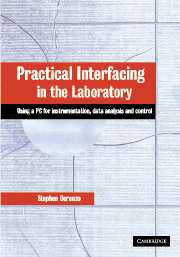Book contents
- Frontmatter
- Contents
- Preface
- Acknowledgments
- 1 Digital tools
- 2 Analog tools
- 3 Analog ↔ digital conversion and sampling
- 4 Sensors and actuators
- 5 Data analysis and control
- Appendix A Grounding and shielding
- Appendix B Experimental uncertainties
- Appendix C C programming tips
- Appendix D Numerical methods and C functions
- Appendix E Summary of Data Translation DT3010 PCI plug-in card
- Appendix F Using the digital oscilloscope to record waveforms
- Appendix G Electrical hazards and safety
- Appendix H Standard resistor and capacitor values
- Appendix I ASCII character set codes
- Glossary
- Index
- References
4 - Sensors and actuators
Published online by Cambridge University Press: 04 August 2010
- Frontmatter
- Contents
- Preface
- Acknowledgments
- 1 Digital tools
- 2 Analog tools
- 3 Analog ↔ digital conversion and sampling
- 4 Sensors and actuators
- 5 Data analysis and control
- Appendix A Grounding and shielding
- Appendix B Experimental uncertainties
- Appendix C C programming tips
- Appendix D Numerical methods and C functions
- Appendix E Summary of Data Translation DT3010 PCI plug-in card
- Appendix F Using the digital oscilloscope to record waveforms
- Appendix G Electrical hazards and safety
- Appendix H Standard resistor and capacitor values
- Appendix I ASCII character set codes
- Glossary
- Index
- References
Summary
Introduction
The transducer is a device that converts one form of energy to another. For interfacing to a microcomputer, we are primarily interested in the electronic transducer, which has an input or an output that is electrical in nature, such as a voltage, current, or resistance. The sensor is an electronic transducer that converts a physical quantity into an electrical signal. An actuator is an electronic transducer that converts electrical energy into a physical quantity, and is an essential element in control systems.
Sensors are used to detect displacement, temperature, strain, force, light, etc. Almost all sensors require additional circuits to produce the voltage and current needed for analog-to-digital conversion. As we shall see in this chapter, the thermistor changes its electrical resistance as a function of temperature, and a bridge is needed to produce a corresponding voltage, whereas the silicon photodiode produces a current, and a stage of amplification is needed to produce a voltage. Often, the term “sensor” includes both the transducer and the circuits needed to produce an output voltage.
Laboratory Exercise 11 uses a circular resistor and a computer to record angle and the oscillations of a damped pendulum. Laboratory Exercise 12 explores the measurement of temperature using the dial thermometer, a platinum resistance thermometer, the thermocouple, and the thermistor. Laboratory Exercise 13 measures force, using four metal foil strain gauges bonded to a plastic rod and wired in opposing pairs to form a bridge circuit.
- Type
- Chapter
- Information
- Practical Interfacing in the LaboratoryUsing a PC for Instrumentation, Data Analysis and Control, pp. 226 - 299Publisher: Cambridge University PressPrint publication year: 2003
References
- 1
- Cited by



